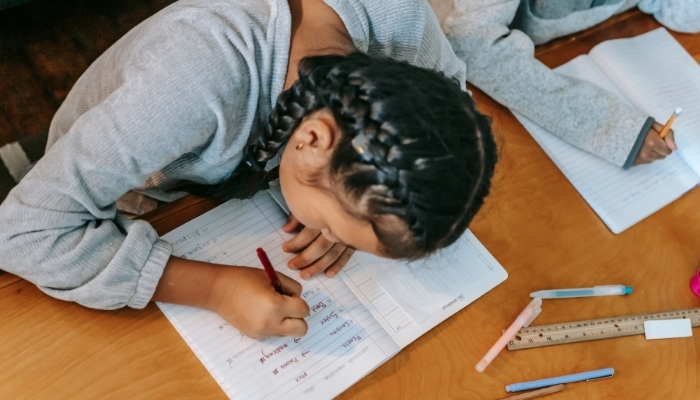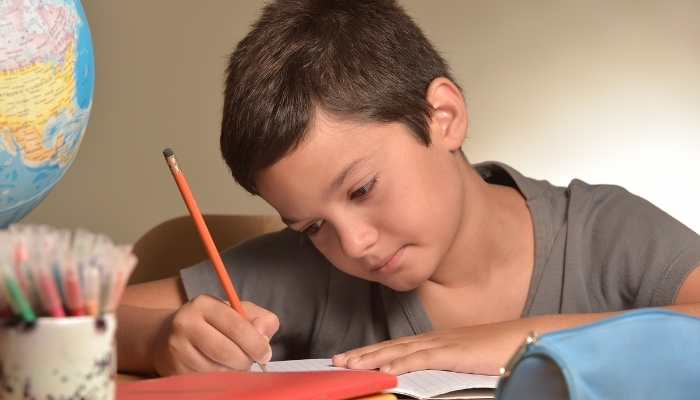Have you noticed your child scribbling letters or trying to write words and wondered if it really helps?
Many parents see their kindergartener struggling to form letters or short sentences and aren’t sure how to support them. At this age, early writing helps develop thinking skills, hand control, and creativity. Giving children regular chances to write builds confidence and helps them express their ideas clearly. Understanding these stages makes it easier for you to guide your child and turn everyday writing moments into fun and meaningful learning experiences.
Quick Overview
-
Children start with scribbles and letter-like forms, gradually progressing to invented spelling and simple sentences as they develop their writing skills.
-
Expect early-year writing to consist of simple drawings and words, mid-year writing to include short stories, and end-of-year writing to feature complete sentences with punctuation.
-
Encourage writing with fun prompts like describing favorite toys, imagining magical worlds, or explaining daily routines to spark creativity and practice storytelling.
-
Set up a writing-friendly space, integrate writing into daily activities, and celebrate progress while focusing on creativity over perfection.
Understanding Kindergarten Writing Development
At this age, your child is starting to experiment with putting their thoughts on paper. You’ll notice their marks slowly turning into shapes, letters, and eventually little sentences that tell a story. Knowing what to expect at each step can help you encourage them and celebrate each small success.

Here’s what you might notice as your child develops their writing skills:
-
Drawing and Scribbling: Your child might draw squiggly lines or shapes and say it’s a “dog” or a “house.”
-
Letter-Like Forms: They start making marks that resemble letters, like “A” as a triangle or “B” as two stacked circles.
-
Invented Spelling: You might see them write “katt” for cat or “hous” for house—matching sounds to letters in their own way.
-
Conventional Spelling: Short sentences appear correctly, like “I see a dog” or “The sun is hot.”
-
Sample Progression: Over the year, scribbles turn into letters, letters turn into words, and words turn into little stories like “My cat ran fast.”
Next, we’ll take a closer look at what kindergarten writing actually looks like at various stages, helping you spot milestones and celebrate each one.
Writing Samples: What Should Kindergarteners Be Able to Do?
Kindergarteners are just beginning to put their ideas into words, and their writing abilities grow quickly over the year. Understanding what kinds of writing to expect helps you see how your child is progressing and where they might need encouragement.
Here’s a breakdown of typical writing milestones throughout the year:
1. Early-Year Samples
At the start of kindergarten, your child’s writing is mostly about exploring letters, sounds, and ideas.
To get a sense of what’s normal at this stage, here are some examples:
-
-
Simple drawings labeled with one or two words, like “dog” or “car.”
-
Short phrases or sentences using common sight words, such as “I see a cat.”
-
Beginning attempts at forming letters correctly, even if some are backwards or uneven.
-
2. Mid-Year Samples
By the middle of the year, children start stringing words together to tell small stories or explain ideas.
Here’s what you might notice in your child’s writing around this time:
-
Basic stories with a beginning, middle, and end, like “I went to the park. I played on the slide. I had ice cream.”
-
Use of capital letters and punctuation at the start and end of sentences.
-
Improved spelling of common words, though invented spelling may still appear for tricky words.
3. End-of-Year Samples
Towards the end of kindergarten, children can write simple stories and express ideas more clearly.
Here’s what their writing might look like:
-
Complete sentences with correct spacing and punctuation.
-
Ability to 1, like describing steps in making a sandwich or planting a seed.
-
Short stories or descriptions that reflect their thoughts, such as “My cat is fluffy. She likes to sleep on my bed.”
So let’s turn our attention now to the types of prompts that can ignite your child's imagination and support their development through fun and creative exercises.
Also read: Kindergarten Story Writing Steps, Tips, and Techniques for Kids
Creative Writing Prompts for Kindergarteners
Giving your child prompts can turn everyday ideas into fun writing exercises. Prompts help spark imagination, encourage clear thinking, and make writing a natural part of their day. Here are some types of prompts you can try and how to make them practical for your child:
1. Imaginative Prompts
Imaginative prompts encourage kids to think creatively and invent stories beyond their everyday experiences.
Here are some ideas to try with your child:
-
If you could be any animal for a day, what would you be and why?” -Encourage them to describe what they would do, where they would go, and who they might meet.
-
“Imagine a day in a magical forest. What happens there?” -They can draw first and then write short sentences to describe the scene.
-
“What would you do if your toys came to life?” -Let them act out the story first, then write it down.
2. Descriptive Prompts
Descriptive prompts help children practice observation and expressing details clearly.
Here are some examples:
-
Describe your favorite toy. What does it look like? What makes it special?” -They can look at the toy while writing, which improves attention to detail.
-
“Describe your dream house. What rooms does it have? What colors do you see?” - Drawing a quick sketch before writing can help organize their ideas.
-
“What’s your favorite snack? How does it taste and smell?” -This encourages using descriptive words beyond just naming the object.
3. Sequential or “Step-by-Step” Prompts
Sequential prompts teach children to organize thoughts logically, a key writing skill.
Try these scenarios:
-
“Tell the story of how you made your breakfast today.” -Guide them to write step-by-step sentences like “I poured the cereal. I added milk. I ate it with a spoon.”
-
“Explain how to plant a seed in a pot.” -They can write sentences in order, showing cause and effect.
-
“Describe how you get ready for school in the morning.” -Helps children practice sequencing everyday routines.
Let’s focus now on exploring some strategies that can make writing a more natural and engaging activity at home, with simple ideas that fit seamlessly into your daily routine.
Strategies to Encourage Writing at Home
Helping your child practice writing at home makes learning more meaningful and enjoyable, while also building their confidence. Here are some simple ways you can support and inspire your child’s writing every day:

-
Create a Writing-Friendly Space:
-
Set up a small area with paper, pencils, crayons, and fun stationery.
-
Include a little display board or folder to showcase their work, which boosts motivation.
-
-
Incorporate Writing into Daily Routines:
-
Encourage writing grocery lists together: “Can you write down the fruits we need?”
-
Have your child make thank-you notes or simple messages for family members.
-
Ask them to journal short experiences, like what they did at school or during playtime.
-
-
Read and Talk Together:
-
Read stories aloud and pause to ask your child to predict what happens next.
-
Encourage them to retell the story in their own words, either verbally or in writing.
-
-
Celebrate Effort, Not Perfection:
-
Focus on creativity and ideas rather than spelling mistakes.
-
Praise their persistence: “I love how you kept writing your story even when it got tricky!”
-
-
Use Everyday Experiences:
-
Writing about activities like baking cookies or planting seeds helps make writing practical.
-
Encourage descriptions of outings, like a trip to the park or zoo.
-
Let them draw first and then write sentences to explain their picture.
-
Now, it’s important to take a closer look at how you can assess your child’s development, making sure to celebrate their achievements while supporting areas that need a bit more attention.
Also read: Fun Ways to Teach Writing Letters That Make Learning Enjoyable
Assessing Kindergarten Writing Progress
Keeping an eye on your child’s writing development helps you understand what skills they’re mastering and where they might need extra support. You don’t need to be a teacher; just a little observation and simple tools can give you a clear picture.
Key Indicators:
-
Correct Letter Formation and Word Spacing: Notice if your child is forming letters neatly and leaving spaces between words. For example, “I see a cat” should have space between each word, even if some letters are still backwards.
-
Proper Use of Punctuation and Capitalization: Check if they start sentences with a capital letter and end with a period. You might see sentences like “My dog runs fast” gradually appearing in their work.
-
Clear Expression of Ideas: Look at whether your child can convey a simple story or idea in writing. For instance, “I baked a cake. It was chocolate. I shared it with my brother.” shows they’re connecting thoughts logically.
Tools for Assessment:
-
Checklists and Rubrics: Simple charts can help you track progress, like marking whether they used spacing, punctuation, or complete sentences correctly.
-
Regular Observations and Feedback: Watch them write during play or daily activities and give gentle feedback. Saying things like, “I love how you explained your drawing!” encourages improvement without pressure.
Now, let’s talk about how FunFox can be a perfect match for young learners in need of both structure and fun.
Why FunFox is the Best Choice for Young Writers?
Watching your child struggle to put ideas on paper can be frustrating, and you might worry they’re falling behind in writing. FunFox makes this journey easier, turning writing into a fun and confidence-building experience that children actually look forward to. Here’s how FunFox helps your little writer thrive:

-
Small, Supportive Classes: With just 3–6 children per class, your child gets real attention and guidance.
-
Friendly, Experienced Teachers: Skilled educators encourage creativity, celebrate effort, and help children express their ideas clearly.
-
Step-by-Step Learning: Writing lessons are designed to gradually build spelling, punctuation, and storytelling skills.
-
Engaging Prompts & Activities: Children explore their imagination, describe experiences, and create stories that reflect their personality.
-
Built-In Feedback: Gentle guidance during every session ensures progress without pressure or overwhelm.
-
Flexible Online Format: Join from home, with access to recordings to catch up anytime.
Conclusion
Writing in kindergarten lays the foundation for your child’s confidence, creativity, and future literacy skills. By providing daily opportunities to explore letters, sentences, and stories, you help them develop essential communication abilities. Encouraging writing early makes learning enjoyable and sets your child up for success in school and beyond.
FunFox supports young learners in this journey by offering small, engaging classes led by experienced teachers who make writing fun and meaningful. With activities designed to build skills step by step and personalized feedback in every session, children gain both confidence and competence. Parents can trust FunFox to guide their child through a nurturing, structured, and inspiring learning environment.
Frequently Asked Questions
1. What writing skills should my kindergartener be developing?
At this stage, children start with drawing and scribbling, move on to letter-like forms, and eventually begin forming simple sentences using sight words. Encouraging storytelling and daily writing helps them express ideas clearly.
2. How can I make writing fun for my child at home?
Turn everyday activities into writing opportunities, like making grocery lists, drawing comics, or describing their favorite toy. Celebrate their efforts and let them see writing as a creative, enjoyable activity.
3. How often should my child practice writing?
Even 10–15 minutes a day can make a difference. Short, consistent practice builds confidence and reinforces fine motor skills without overwhelming them.
4. How do I know if my child is progressing?
Look for neat letter formation, proper spacing between words, punctuation, and their ability to express ideas in sentences. Observing their work over time shows growth and highlights areas needing support.
5. What are some easy prompts to encourage writing at home?
Ask questions like “If you could be any animal, what would you be?” or “Describe your dream day.” Prompts that relate to their experiences and imagination make writing exciting and relatable.















